History of Hoysala temple architecture
Hoysala architecture is renowned for their exquisite temple architecture, detailed ornamental elaboration and intricate art work on sandstone sculptures which sets them apart from other historical monuments of the same era. The peak of Hoysala architecture is evident in the Hoysaleswara Temple, Halebidu and Cheenakeshava temple at Belur.
Vishnuvardhana , the Hoysala dynasty king was a subordinate of the western Chalukyas who later declared his independence from them. After liberating himself from Chalukyas, he wanted to excel the Chalukyan achievements in the field of temple architecture which inspired the construction of about 1500 temples in 958 centres, built during the Hoysala period – between A.D. 1000 and A.D.1346 of which about a hundred temples have survived to date.
Halebidu was the capital of the Hoysala empire in 12th-13th century. It was originally known as Dorasamudra or Dwarasamudra due to it’s proximity to the Dorasamudhra lake. However, after twice invasion by Malik Kafur, the Hoysala Dynasty left Halebidu and shifted their capital to Belur which is 16 km away, hence the name Halebidu (means”old city”).
Haledidu is located in Hassan district, Karnastaka at a distance of 23 km from Belur, 38 km from Chikmagalur, 33 km from Hassan & 209 km from Bangalore.It about 4.5 hours drive from Bangalore.
Hoysaleswara Temple, Halebidu
The Hoysalaleswara temple was built by Vishnuvardhana who succeeded to the Hoysala throne in the early 12th century and completed this temple in A.D. 1150.
Hoysaleswara Temple is a dvikuta temple dedicated to Hindu god Shiva comprising of two shrines of Hoysaleswara and Shantaleswara located next to each other facing east and were named after King Vishnuvardhana Hoysala and his Queen Shantala Devi.
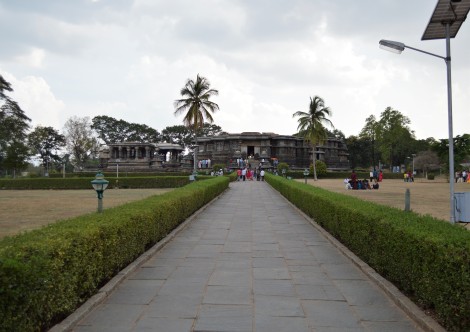
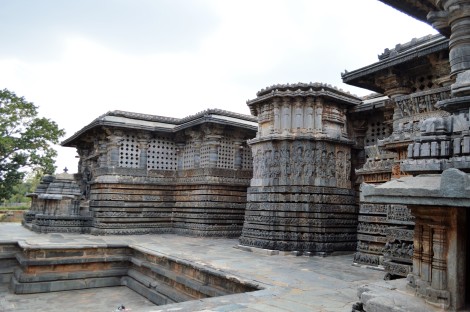
Carving on exterior walls : The lower walls of temple are decorated with elephant (signifying strength), lion ( signifying courage) and horses (signifying speed ) and circular carving (for artistic supremacy) of Hoysala dynasty. Also visible is the Samundra Manthan ( churning of the ocean) on 6th row from bottom.
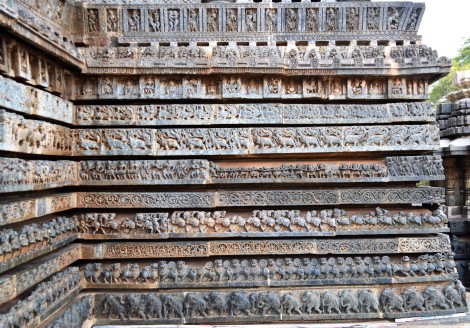
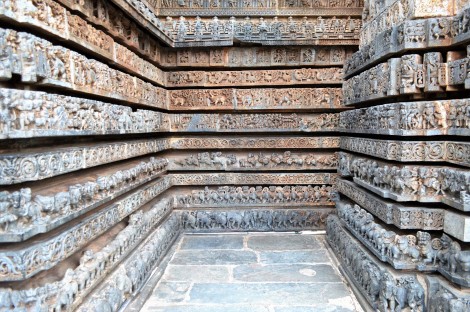
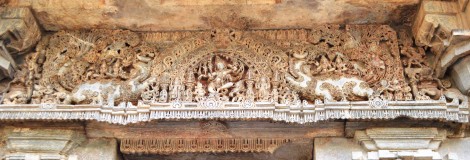
Shiva as Natraja
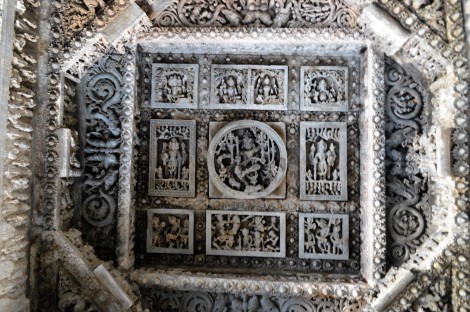
Carving on the temple roof
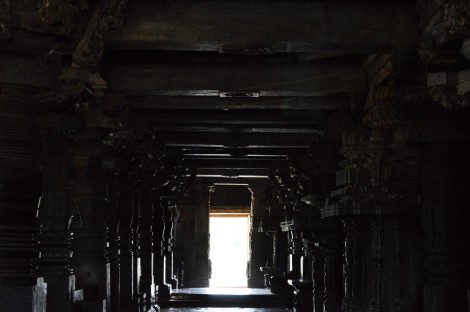
Inside view of temple pillars
Gatekeepers at the temple entrance: One can observe the detail ornamentation and the expressive eyes of the gatekeeper at the temple entrance.
Some interesting things to know:
- Despite 86 years of labour, the temple was never completed.
- The building of the temple was funded by the affluent Shaiva citizens (mainly Ketamalla and Kesarasetti) of Halebid as a result of competition to the construction of the Chennakesava Temple at Belur, a Vaishnava (a Hindu sect) temple.
- The temple was built using soapstone (chloritic chist) which is apt for the intricate sculptures and detailed art work, hallmark of Hoysala architecture.
- The temple complex as a whole is elevated on a star shaped platform which is prominent design in Hoysala architecture.
- The temple was built in star shaped design similar to Chennakeshava temple at Belur which gives it overall unique view
Mythological stories sculptures
Krishna lifting the Govardhana mountain: Beautifully depicted is the Hindu God Krishna ligting with one hand Govardhana mountain and held it up as protection to his people and cattle from the rain. Indra finally accepted defeat and recognized Krishna as supreme.
Once can observe the intricately carved forest with one archer hunting in the center, one monkey on the right top.
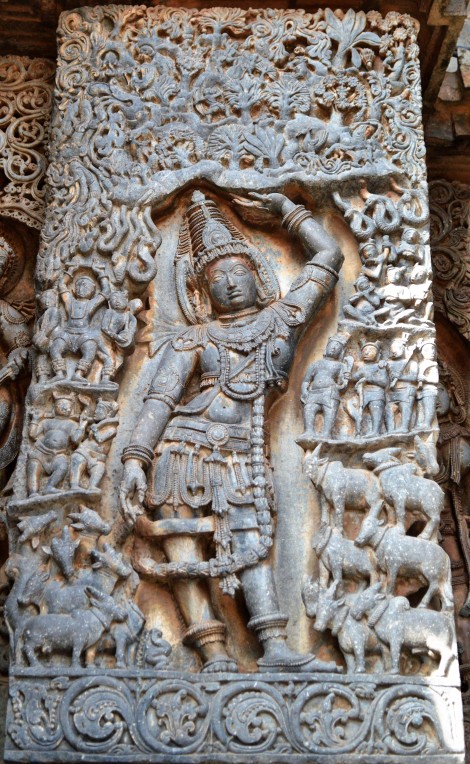
Krishna lifting Govardhana mountain
Vishnu battle with Indra: One can see Hindu God Vishnu on Garuda and Indra on his elephant Airavat. The
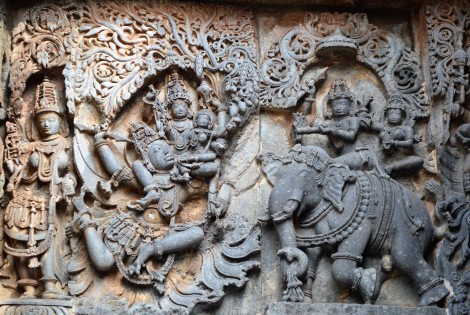
Vishnu battle with Indra
Gajasurasamhara : Hindu god Shiva depicted as the Destroyer of the elephant demon. When an demonassumed the form of an elephant and terrorized Brahmins who were worshipping the linga, Shiva emerged from this linga, slayed the demon, and removed the elephant skin, thereafter wearing the hide on his upper body with Gajasura head under his feet.
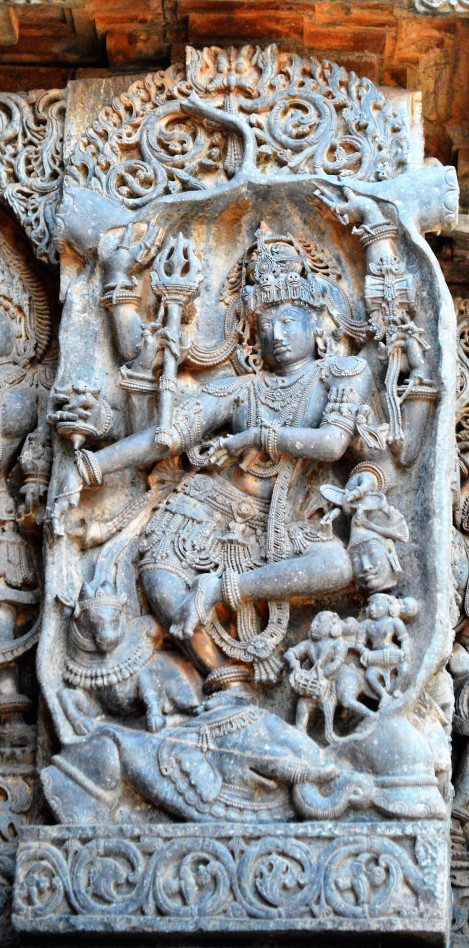
Shiva – Gajasurasamhara
Vishnu as Vamana: Vishnu in Vamana avatar, a dwarf Brahmin, approached Mahabali and request three paces of land. Bali agreed, and the dwarf then changed his size to that of a giant. He stepped over heaven in his first stride, and the netherworld with the second. Bali realized that Vamana was Vishnu incarnate and offered his head as the third place for Vamana to place his foot. The avatar did so and thus granted Bali immortality. One can see the right leg of Vishnu in the heaven where Hindu god Bramha placed.
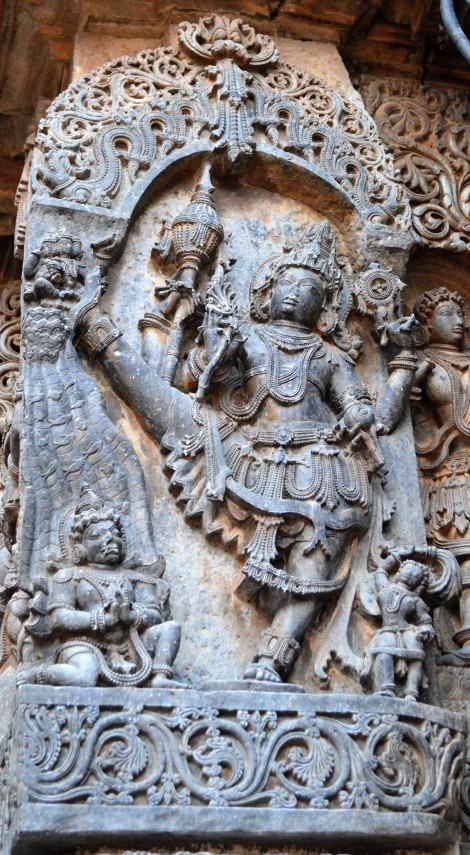
Vishnu as Vamana
Ravana lifting Kailasha: Portrayal of Ravana trying to lift Mount Kailash. As per legend, Shiva pushed the mountain into place and trapped Ravana beneath it with his legs bend.
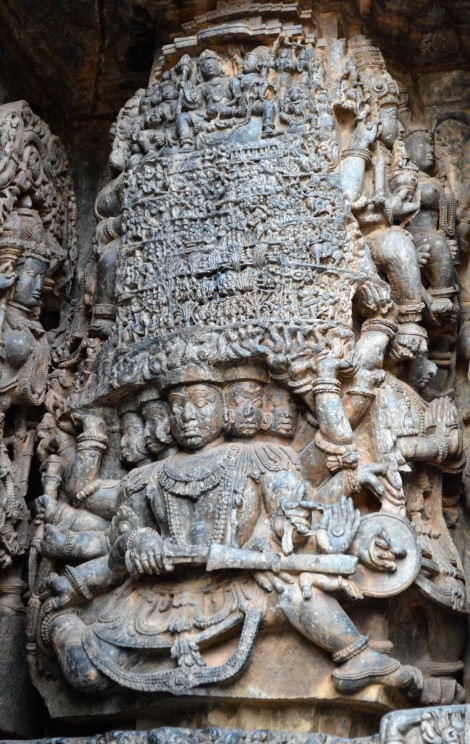
Ravana lifting Kailasha
Rama killing of Bali : Portrayal of Rama killing bali behind the trees during Bali fight with Sugriv in Ramayana.
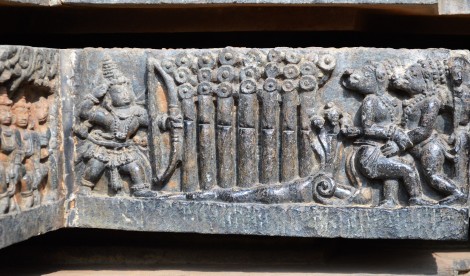
Rama killing Bali behind the trees
Vishnu – Narasimha Avatar: Lord Vishnu takes the form of Narasimha in his fourth incarnation and kills the demon Hiranyaksha. One can see the nails of Lord Vishnu piercing the body of Hiranyaksha.
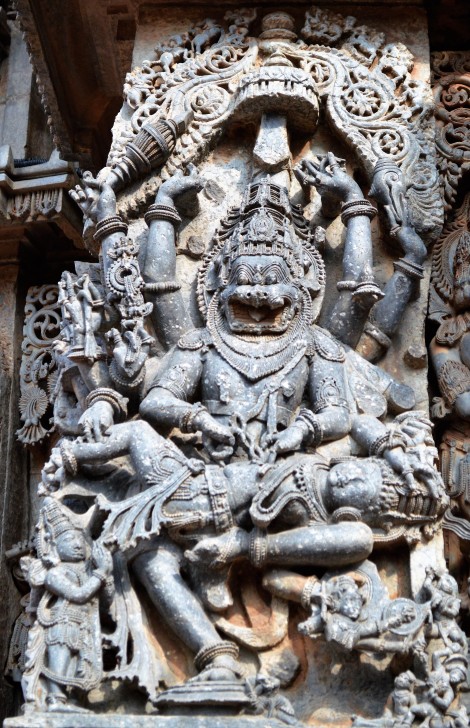
Vishnu – Narasimha avatar
One of the largest Nandi sculpture
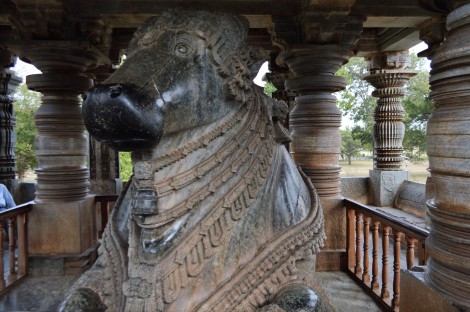
Ganesha on mouse: One can observe the impact of weight of Hindu god Ganesh from pressing of earth at the second leg of Mouse ( carrier of Ganesha) due to weight on Hindu God Ganesha.
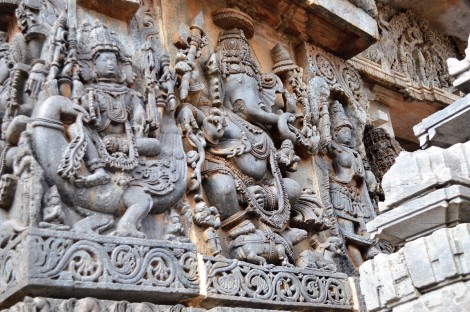
Pressure on earth due to Ganesha weight on mouse
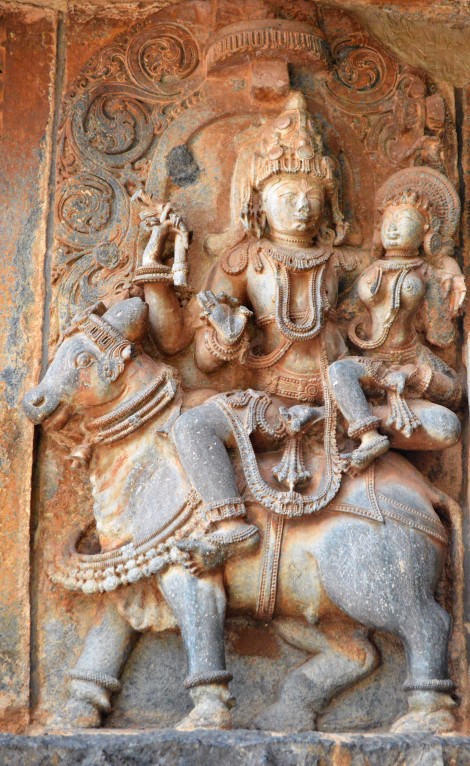
Shiva and Parvathi on Nandi
Effect of wine: Beautiful effect of drinking wine is shown. It is shown as good if one drinks in moderation as a bird but is a poison in excess as shown as snake.
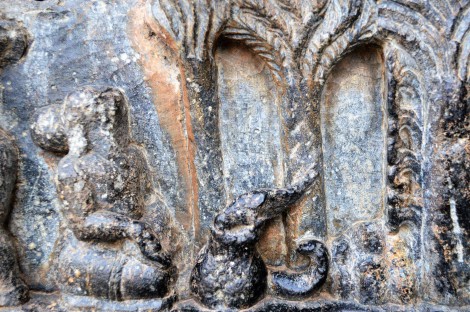
Effect of wine
Battle scene with multiple arrows
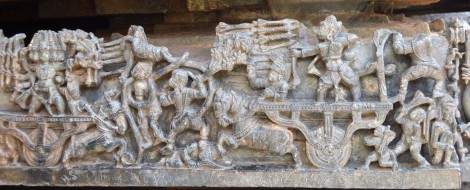
Battle scene with multiple arrows
Darpana Sundari
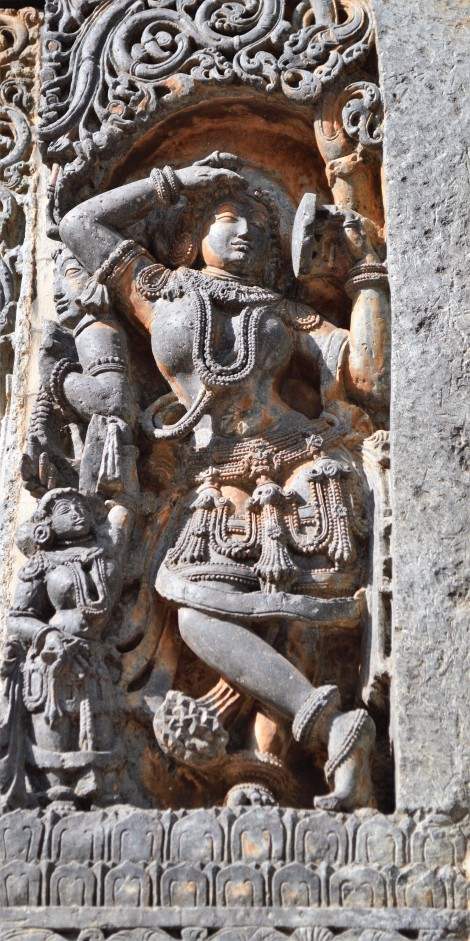
Darpana sundari
Imaginary animal sculpture: Sculpture of an imaginary animal with pig body, tail of peacock, crocodile teeth
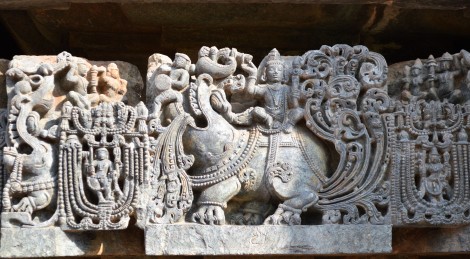
In the end, the only word to describe my visit is “spellbound”.
Tips:
- Best time to visit: October – February
- Must include the following Hoysala temples in your travel list:
- Chennakeshava Temple, Belur
- Veera Narayana Temple, Belavadi
- Lakshmidevi temple, Doddagaddavalli



Reblogged this on Third Eye View and commented:
Picture from visit to Hoysalewara temple, Halebidu
LikeLike
These pictures are really fascinating.
LikeLiked by 1 person
Thanks.
LikeLike
Pingback: Chennakesava Temple, Belur – Hoysala Architecture excellence | My travel sojourns·
Pingback: Veera Narayana Temple, Belavadi – a lesser known architectural wonder of Hoysala architecture | My travel sojourns·
Pingback: Ishvara Temple, Arasikere – a forgotton gem of Hoysala architecture | My travel sojourns·